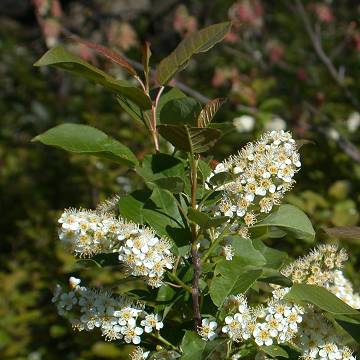

Prunus virginiana - (image 1 of 6)
Taxonomy
Family: Rosaceae
Habitat
Found in a wide range of habitats, including woodlands, sandy soils, mesic wooded dunes.
Associates
In woodlands with Acer saccharum, Claytonia virginica, Fraxinus americana, Geranium maculatum, Osmorhiza claytonii, Parthenocissus quinquefolia, Prunus serotina, Quercus rubra, Sambucus canadensis, Sanicula gregaria, Smilacina racemosa, Tilia americana, Vitis riparia.
Distribution
Most of the US except the extreme southeast and parts of the west. Most of Canada except coastal British Columbia.
Morphology
Small tree or large shrub, usually multi-stemmed and suckering, deciduous. Leaves broadly oval to obovate, less than twice as long as wide, to 5" long, dull green, lighter beneath; teeth sharp, eglandular. Young stems smooth or with fine scales, dark gray-brown; mature bark darker with lighter, non-horizontal lenticels. Flowers white, somewhat greenish, in racemes to 6" and 1" wide; calyx lobes broad, obtuse, glandular, not persisting with the fruit; petals less than 5 mm long; hypanthium glabrous within. Fruit a round drupe, very bitter, stone smooth.
Notes
Flowers mid April to late July
Wetland indicator: Facultative Upland, Facultative
Can grow to 30' high and almost equal spread, sometimes occurring as a tree with a few main trunks. Birds devour the fruits as quickly as they ripen. Although reputed to be edible, the fruit is so astringent that it is nearly impossible to swallow, hence the name "Choke Cherry".
Several purple-leaves cultivars are available, such as 'Schubert', 'Canada Red', 'Mini-Schubert', and 'Robert'. Seedlings of 'Schubert' often retain the purple foliage trait, as can be seed in the last image. Note the loss of pigment on the youngest growth which occurs in warm weather. Fall color can be a good purple-red but leaves tend to drop too quickly for it to be effective.
References
Dirr, Michael A. 1998. Manual of Woody Landscape Plants:
Their Identification, Ornamental Characteristics, Culture, Propagation and Uses.
5th ed. Champaign, Illinois: Stipes Publishing L.L.C.
Farrar, J. L. 1995. Trees of the Northern United States and Canada.
Ames, Iowa: Iowa State University Press.
Swink, F. and G. Wilhelm. 1994. Plants of the Chicago Region.
Indiana Academy of Science. The Morton Arboretum. Lisle, Illinois.
|
Michael Hough © 2005 |